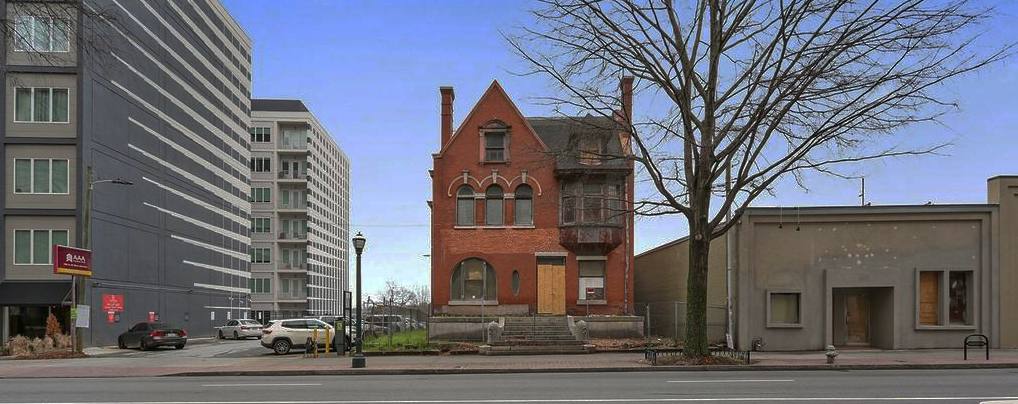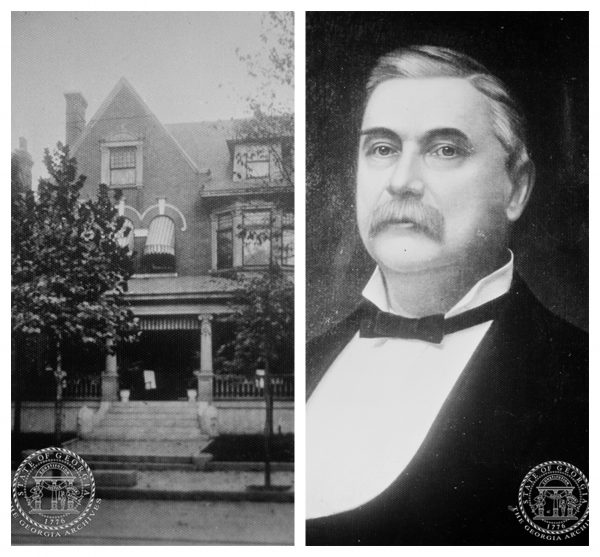How Atlanta’s Rose House Ended Up As One Of The Last Of Its Kind

Rufus Rose house is one of an all but dead breed: stately mansions that once lined Peachtree Street.
Courtesy of Stacia Oberweis / Keller Williams Realty Atlanta Midtown
When Rufus M. Rose, the possible namesake of Four Roses Bourbon, decided he wanted to build a home for his family in Atlanta, he turned to architect E.C Seiz. A wealthy businessman — he founded R. M. Rose Co. Distillery in Vinings — Rose wanted a home with all the modern conveniences that the early 1900s could offer, including gas, electricity and running water.
Seiz delivered, constructing for him a grand Queen Anne Victorian-style mansion at 481(now 537) Peachtree Street, wrapped in deep red brick with arched front windows.
The home would have 2.5 stories, five bedrooms, three bathrooms, nine fireplaces, a ballroom and a library, stained glass windows, hardwood floors, ornamental millwork and carved woodwork throughout. “No expense was spared” in its construction, according to notes made on the home’s nomination form for the National Register of Historic Places.

Seiz completed the Rufus Rose House in May 1901 for $9,000. Members of the Rose family lived there until 1921, then sold the house in 1923 for $61,625. The property served as the location for the Atlanta Museum from 1945 to 1993. It was also the location of the Atlanta Preservation Center from 1999 to 2001.
The current owner bought the Rose House at auction in 2011.
While there were talks back in 2015 of converting the home into an arts space, the idea never came to fruition, and now Rufus Rose’s family home is back on the market again, listed for $1 million.
The Peachtree Street Of The Past
At the time of construction, the Rufus Rose House was one of many similar mansions dotting the street and surrounding neighborhood. According to the Urban Design Commission, the Rose House “conveys a sense of residential Peachtree at a time when streetcars, not automobiles, determined the patterns of residential development…”
Indeed, grand Victorian homes such as the Leyden House, Raoul House, Rhodes Hall, Margaret Mitchell’s family home and the first Governor’s Mansion would have been located nearby.
“While we don’t know for sure, it’s likely that Rose chose Peachtree Street because of its status,” says Amber Rhea, an architectural historian and finance committee chair of Historic Atlanta who’s worked closely with the home’s listing agent and seller. “At the time, this stretch of Peachtree was lined with large, stately homes of wealthy and influential Atlantans.”
Doug Young, assistant director of the city’s Historic Preservation Office, echoed those thoughts.
“Peachtree Street and other north-south streets nearby would have had a high significance of address,” he said. “Those would have been folks that could afford to live on that premier street.”
One Of The Last Of Its Kind
The commercial growth of the city came at the expense of this grand architectural history. Many of those glorious old homes were destroyed in fires, “a common occurrence when fireplaces were the source of heat,” says Rhea, but nearly all of the ones that survived would be razed for development, as Atlanta began to boom as a hub for transportation and business.
Now, the Rufus Rose House stands defiantly as one of the very last of its kind, a reminder of a bygone Atlanta, its deep red brick declaring the city’s cultural heritage out loud among the dull grey of the surrounding properties.
Its value and importance as a relic of the city’s architectural heritage, says the Urban Design Commission, “cannot be overstated.”
Places like the Rufus Rose House “provide a level of authenticity to the city,” says Young. “…the other thing historic properties [like the Rose House] do is provide a way to understand the city’s history, because by their very design — the way they’re designed, their location, the stories that go along with them — they are a window into the past. It shows us from where we have come, and allows us to understand the evolution of the city of Atlanta.”
Rhea agrees.
“Historic properties connect us to our past and provide a strong sense of place,” she says. “In the case of the Rufus M. Rose House, it is one of the few pieces of the built environment in the area that is able to provide a connection to Atlanta at the turn of the 19th/20th century.”
It’s also a case study in the importance of historic preservation from an economic, sustainability and community investment perspective, says Rhea.
“Historic preservation creates more jobs and keeps more money within the local community than demolition and new construction, [and] state and federal tax incentive programs for historic preservation projects make a property such as the Rufus M. Rose House a wiser investment than new construction.”
The Rufus Rose House was added to the National Register of Historic Places in 1977, and the city of Atlanta designated it a Landmark Building in 1989. The home cannot be demolished or have its historical features altered; it’s also eligible for federal and state tax credits for rehabilitation.
This means that, according to information from Historic Atlanta based on a Conditions Assessment Report conducted by Surber Barber Choate & Hertlein Architects in 2016, a future buyer of the home “undertaking a rehabilitation project with historic tax credits could expect to receive up to approximately $400,000 in federal tax credits and approximately $500,000 in state tax credits.”
Historic Atlanta is also offering the buyer of the property five donated hours of consultation and assistance in the preparation of the application for those credits.
It’s good to know that so many protections are in place for a home that holds so much of Atlanta’s history within its walls, that a piece of the city’s past will endure its future, regardless of who holds the keys.
Correction: This report has been updated to reflect architectural historian Amber Rhea’s proper title.


















